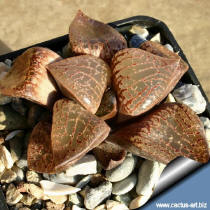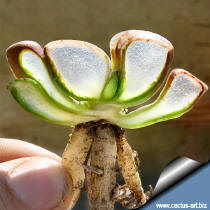|

Photo 1: windowed
reticulated
leaves of
Haworthia emelyae
v. comptoniana

photo 2: A
longitudinal section showing the
transparent
tissues. |
Windowed growth
habit of some
subterranean
leaf
succulents.
A number of South African
succulents
like Lithops ssp.
and Haworthia ssp.
(See: photo 1 and 2 ) to escape the killing
heat of the
desert
grow almost
entirely
subterranean and have
evolved
special fenestrate (windowed)
leaves that
grow below
the
surface of the soil; This
succulent
leaves have a
nearly
transparent flat
apex
exposed
to the
atmosphere and are even at the
soil level. This permit the
plants to
minimize the
heating effects of high
light intensity and to reduce the
drying effects
of desert
air during
prolonged
drought. There are no
stomata in
the windows, so little water
is lost, these plants remain
subterranean because they have
contractile roots which continually pull the plants deeper
into the ground
as the stem
elongates.
The disadvantage, however, is the limited amount of
leaf
surface
area exposed
to the
sun for
photosynthesis to supply
food for the
plant but the
translucent
window in the top
surface,
however, the fenestration allow
sunlight to be captured and utilized even when the plant are
retracted
below the
surface of the soil. This is an interesting
evolutionary
adaptation
to overcome this
light problem; their
leaves are a
simple optical system that permits
light
striking the windows to be
diffused
onto the green,
photosynthesizing surface situated
underground.
So, with a minimum of
exposure
to the outside
environment,
a maximum area of
photosynthetic
tissue is
ensured.
|